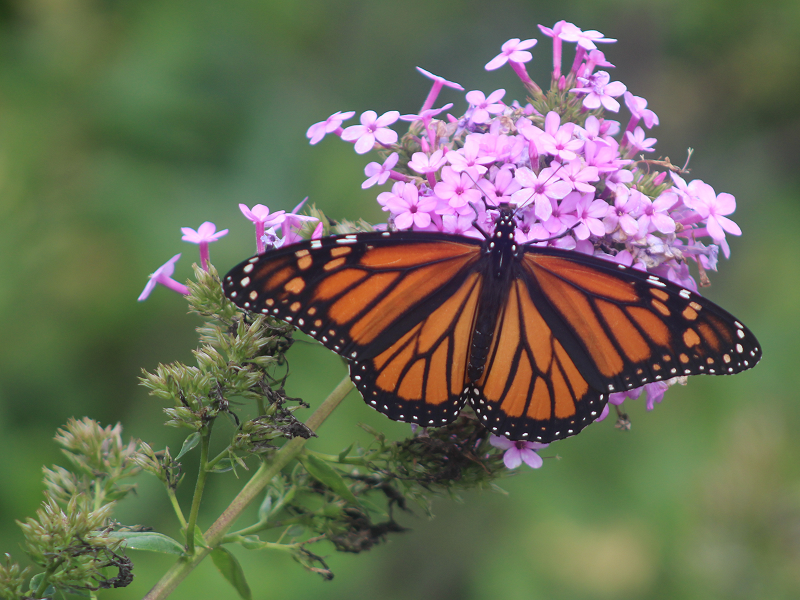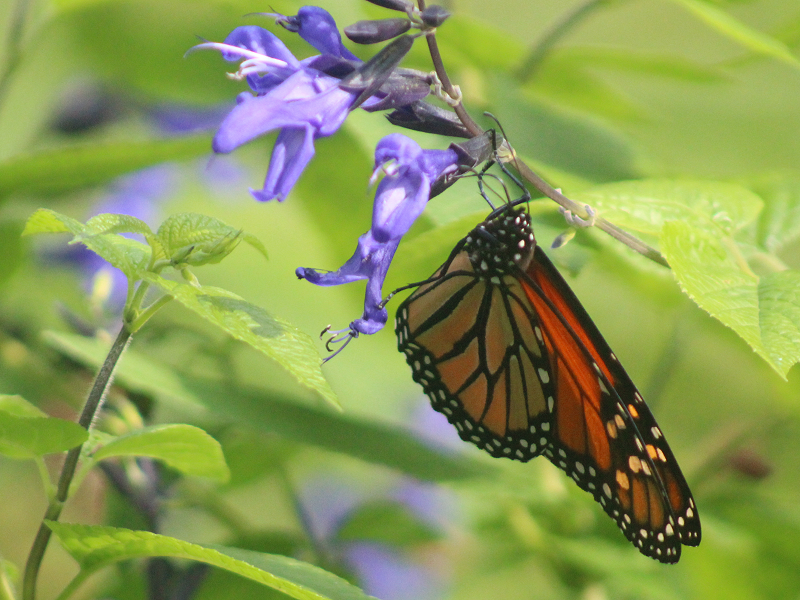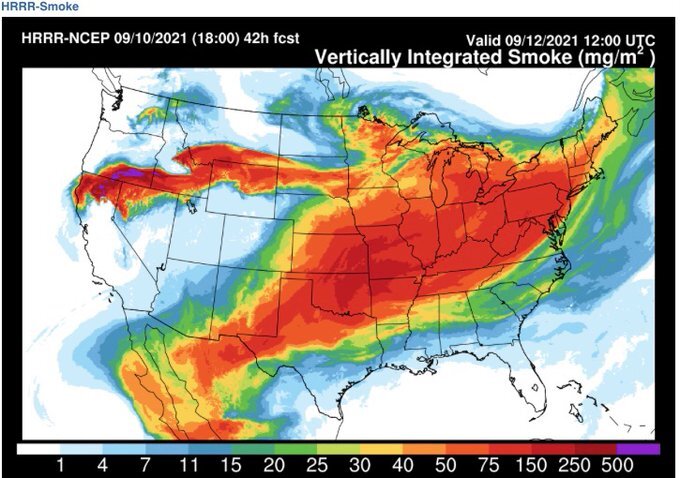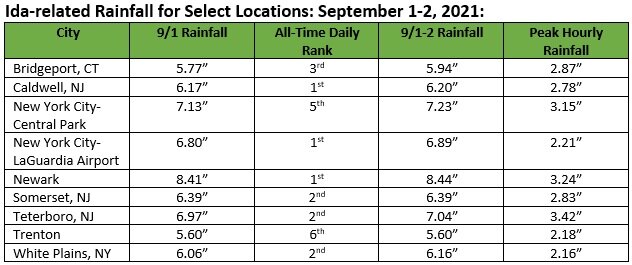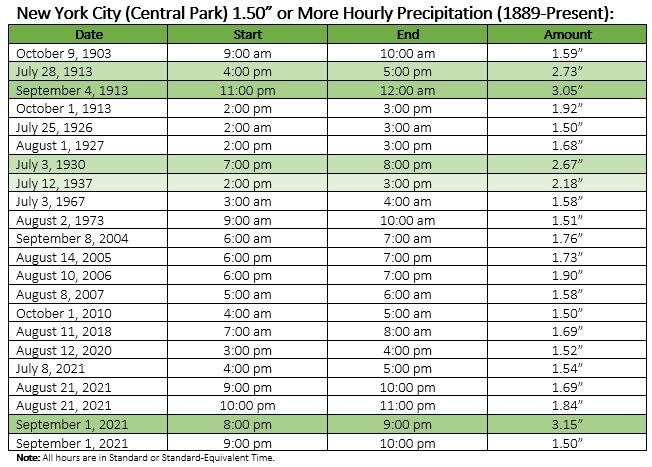-
Posts
22,866 -
Joined
Content Type
Profiles
Blogs
Forums
American Weather
Media Demo
Store
Gallery
Everything posted by donsutherland1
-
Temperatures rose into the middle and upper 70s with a few lower 80s today. Out West, more record heat prevailed. Denver saw the temperature reach 97°, which easily surpassed the daily record of 93° from 2018. Today was the 3rd consecutive 95° or above temperature in Denver, the latest such stretch on record. The prior record was set during September 5-7, 2013. 10/14 (71%) of Denver's 97° or above September temperatures have occurred since 2010. Records go back to 1872. Cheyenne had a high temperature of 91°. The previous daily record was 88°, which was set in 1954 and tied in 2016. September 9-11, 2021 is Cheyenne's latest-season heatwave on record. The prior latest heatwave occurred during September 6-8, 1959. Tomorrow will be unseasonably warm with temperatures rising into the middle and upper 80s as far north as New York City. Thick wildfire smoke could again push into the region overnight. Some of the guidance--the GFS in particular--is hinting at a potential tropical-enhanced rain event for late next week into next weekend. The GFS's run-to-run consistency suggests that the potential be watched closely. Despite a cooler than normal first 7-10 days, September will likely feature near normal to somewhat warmer than normal temperatures in much of the region. The second half of the month could feature above to perhaps much above normal temperatures. As a result, 2021 is increasingly likely to become the 6th out of the last 7 years during which September has had a mean temperature of 70° or above in New York City. Prior to 2000, New York City saw such warmth on average once every five years. In short, September has become more an extension of summer than a gateway to autumn in the New York City area. Fall 2021 will likely be wetter to much wetter than normal in the northern Middle Atlantic region. Since 1869, there have been 9 August cases where New York City picked up 20.00" or more rainfall during the summer. Two thirds of those cases (and 4/5 of those with summer mean temperatures of 73.0° or above) had 17.00" or more fall precipitation in New York City. 2011 is probably the closest match in terms of precipitation and a nearly identical summer mean temperature. Mean fall precipitation for those 9 cases was 14.86". The median was 17.35". The 1991-2020 normal value is 12.27". The ENSO Region 1+2 anomaly was -0.2°C and the Region 3.4 anomaly was -0.3°C for the week centered around September 1. For the past six weeks, the ENSO Region 1+2 anomaly has averaged +0.22°C and the ENSO Region 3.4 anomaly has averaged -0.43°C. Neutral ENSO conditions will likely prevail through September. Afterward, La Niña conditions could begin to develop. The SOI was +4.04 today. The preliminary Arctic Oscillation (AO) figure was -0.834 today. On September 9 the MJO was in Phase 3 at an amplitude of 1.303 (RMM). The September 8-adjusted amplitude was 1.279 (RMM). Based on sensitivity analysis applied to the latest guidance, there is an implied 74% probability that New York City will have a warmer than normal September (1991-2020 normal). September will likely finish with a mean temperature near 70.7° (1.5° above normal).
-
Under partly to mostly sunny skies, the temperature rose into the middle and upper 70s. There is now an abundance of Monarchs at the New York Botanical Garden:
-
Yes, the tropical rainforests are more significant, but a precedent based on expediency would only give further cover for Brazil to continue to develop the Amazon rainforest area. Better building codes, reduced development in highest risk areas (current and modeled) and sustained decarbonization are needed.
-
Morning thoughts… Today will be mostly sunny and warm. High temperatures will likely reach the upper 70s and lower 80s in most of the region. Likely high temperatures around the region include: New York City (Central Park): 78° Newark: 82° Philadelphia: 80° Normals: New York City: 30-Year: 78.0°; 15-Year: 78.5° Newark: 30-Year: 79.5°; 15-Year: 80.0° Philadelphia: 30-Year: 80.7°; 15-Year: 81.0° Tomorrow and Monday will be very warm days. At Denver, the temperature could reach 95° or above for the third consecutive day. That would surpass the daily record of 93° from 2018. It would also set the record for the latest stretch of three consecutive days at or above 95°, which occurred on September 5-7, 2013.
-
The problem with that approach is the precedent it would set, in addition to its reducing a carbon sink. The U.S. retains high global visibility. If it moves dramatically to reduce some of its major forests, others will take license to do the same. One could witness an acceleration of the destruction of the Amazon, Burmese tropical rainforest, Congo rainforest. The rationale would be framed in self-interest. With reduced carbon uptake, emissions would then need to decline even more rapidly, as a higher share would wind up in the atmosphere. The end result would be more weather extremes and such extremes are non-linear in nature. Potential game-changer tipping points would come up much faster. In sum, there is no “free lunch.” The long-term consequences would vastly outweigh short-term localized benefits.
-
No. Reducing a natural carbon sink would be very short-sighted. If others imitated such a move, the world would be in a much worse position. Decarbonization is what is necessary. Shortcuts and gimmicks won’t address climate change or its increasingly extreme impacts.
-
Under brilliant sunshine, the temperature rose into the lower and middle 70s across the region. Another similar day is in store tomorrow before warmer air returns. Out West, exceptional heat again toppled records. At Denver, the temperature rose to 99°, which smashed the old record of 93°. The old record was set in 1931 and tied in 1974, 1994, 1998, and 2018. Denver also saw the relative humidity fall to a daily record low 6%. At Cheyenne, the temperature peaked at 96°. That smashed the previous daily record of 88°, which was set in 2012. It also surpassed the September mark of 95°, which was set on September 1, 1995 and tied on September 2, 2019. The previous latest 96° or above temperature was recorded on August 10, 1969. Sunday could be unseasonably warm with temperatures rising into the upper 80s as far north as New York City. Thick wildfire smoke could again push into the region beginning late Saturday. Despite a cooler than normal first 7-10 days, September will likely feature near normal to somewhat warmer than normal temperatures in much of the region. The second half of the month could feature above to perhaps much above normal temperatures. As a result, 2021 is increasingly likely to become the 6th out of the last 7 years during which September has had a mean temperature of 70° or above in New York City. Prior to 2000, New York City saw such warmth on average once every five years. In short, September has become more an extension of summer than a gateway to autumn in the New York City area. Fall 2021 will likely be wetter to much wetter than normal in the northern Middle Atlantic region. Since 1869, there have been 9 August cases where New York City picked up 20.00" or more rainfall during the summer. Two thirds of those cases (and 4/5 of those with summer mean temperatures of 73.0° or above) had 17.00" or more fall precipitation in New York City. 2011 is probably the closest match in terms of precipitation and a nearly identical summer mean temperature. Mean fall precipitation for those 9 cases was 14.86". The median was 17.35". The 1991-2020 normal value is 12.27". The ENSO Region 1+2 anomaly was -0.2°C and the Region 3.4 anomaly was -0.3°C for the week centered around September 1. For the past six weeks, the ENSO Region 1+2 anomaly has averaged +0.22°C and the ENSO Region 3.4 anomaly has averaged -0.43°C. Neutral ENSO conditions will likely prevail through September. Afterward, La Niña conditions could begin to develop. The SOI was -1.25 today. The preliminary Arctic Oscillation (AO) figure was -0.834 today. On September 8 the MJO was in Phase 3 at an amplitude of 1.278 (RMM). The September 7-adjusted amplitude was 1.306 (RMM). Based on sensitivity analysis applied to the latest guidance, there is an implied 69% probability that New York City will have a warmer than normal September (1991-2020 normal). September will likely finish with a mean temperature near 70.4° (1.2° above normal).
-
Parts of the West remained very dry.
-
-
And frequent revisions will very likely be needed.
-
Morning thoughts… Today will be mostly sunny and comfortably warm. High temperatures will likely reach the middle and upper 70s in most of the region. Likely high temperatures around the region include: New York City (Central Park): 76° Newark: 79° Philadelphia: 77° Normals: New York City: 30-Year: 78.4°; 15-Year: 78.8° Newark: 30-Year: 79.8°; 15-Year: 80.3° Philadelphia: 30-Year: 81.0°; 15-Year: 81.3° Sunday and Monday will be very warm days. Out West, Denver will likely smash its daily record high temperature of 93°, which was set in 1931 and tied in 1974, 1994, 1998, and 2018. There is an implied 16% probability that Denver could reach 100°. If so, that would be the latest such temperature on record. The record was set just last year on September 5. Prior to that, the record was September 2, 2019. Prior to the 2010s, the record was set on August 16, 2002. Prior to the 2000s, the record was set on August 14, 1962.
-
Boise has 18 days. The record is 20 days. That record was set in 2003.
-
Boise is 2nd and Denver is 3rd. Bismarck, Fresno, and Seattle set new records for 100 degree days. Portland (OR) and Salt Lake City tied the record for 100 degree days.
-
Much of the region saw cloudy, cool, and sometimes rainy conditions today. With 0.26" of rain, New York City has now picked up 49.44" of rain this year. As a result, there is an implied 86% probability that NYC will see 60" or more precipitation this year for just the 9th time on record. All 8 prior cases have occurred after 1970 and 3 have occurred since 2000. Records go back to 1869. Out West, record heat prevailed in a number of locations. At Phoenix, the temperature soared to 111°. That broke the daily record of 110° that was set in 1974 and tied in 1990. At Boise, the high temperature of 98° smashed the previous record of 95°, which had been set in 1997. At Denver, the temperature rose to 96°, which broke the daily record of 94°. The old record was set in 1931 and tied in 1998 and 1994. Tomorrow will be another very hot day in Denver. The NBE shows a high temperature of 98° with a standard deviation of 2°. That means there is an implied 16% probability that the temperature could reach 100°. The latest 100° reading there was set on September 5, 2020 when the mercury reached 101°. The prior record was 100° on September 2, 2019. A warming trend will likely develop this weekend. Sunday could be unseasonably warm with temperatures rising into the upper 80s as far north as New York City. Despite a cooler than normal first 7-10 days, September will likely feature near normal to somewhat warmer than normal temperatures in much of the region. The second half of the month could feature above to perhaps much above normal temperatures. As a result, 2021 is increasingly likely to become the 6th out of the last 7 years during which September has had a mean temperature of 70° or above in New York City. Prior to 2000, New York City saw such warmth on average once every five years. In short, September has become more an extension of summer than a gateway to autumn in the New York City area. Fall 2021 will likely be wetter to much wetter than normal in the northern Middle Atlantic region. Since 1869, there have been 9 August cases where New York City picked up 20.00" or more rainfall during the summer. Two thirds of those cases (and 4/5 of those with summer mean temperatures of 73.0° or above) had 17.00" or more fall precipitation in New York City. 2011 is probably the closest match in terms of precipitation and a nearly identical summer mean temperature. Mean fall precipitation for those 9 cases was 14.86". The median was 17.35". The 1991-2020 normal value is 12.27". The ENSO Region 1+2 anomaly was -0.2°C and the Region 3.4 anomaly was -0.3°C for the week centered around September 1. For the past six weeks, the ENSO Region 1+2 anomaly has averaged +0.22°C and the ENSO Region 3.4 anomaly has averaged -0.43°C. Neutral ENSO conditions will likely prevail through September. Afterward, La Niña conditions could begin to develop. The SOI was +7.67 today. The preliminary Arctic Oscillation (AO) figure was -0.538 today. On September 7 the MJO was in Phase 4 at an amplitude of 1.306 (RMM). The September 6-adjusted amplitude was 1.100 (RMM). Based on sensitivity analysis applied to the latest guidance, there is an implied 68% probability that New York City will have a warmer than normal September (1991-2020 normal). September will likely finish with a mean temperature near 70.3° (1.1° above normal).
-
Through 2 pm, Central Park has picked up 0.22” of rain, bringing the September total to 7.47”. Central Park needs another 2.53” to reach 10” for a record third consecutive month. Since record-keeping began in 1869, 65 (43%) of years saw 2.53” or more in the September 10-30 timeframe. However, 30 (60%) during the wetter 1971-2020 period saw at least 2.53”.
-
Morning thoughts… Today will be mostly cloudy with periods of rain. Moderate to heavy rain is likely across eastern Long Island into eastern New England. High temperatures will likely reach the lower and middle 70s in most of the region. Likely high temperatures around the region include: New York City (Central Park): 72° Newark: 76° Philadelphia: 74° Normals: New York City: 30-Year: 78.7°; 15-Year: 79.0° Newark: 30-Year: 80.2°; 15-Year: 80.6° Philadelphia: 30-Year: 81.3°; 15-Year: 81.5° A warming trend will develop during the weekend.
-
A cold front will cross the region tonight. In doing so, it will bring showers and thunderstorms to parts of the region. Afterward, the front's progression will slow and there is a possibility that parts of the region will see additional rainfall tomorrow. In general, most of the region will likely see 0.50"-1.50" of rain. Some areas, especially northwestern New Jersey and northeastern Pennsylvania could see 2"-3" rainfall amounts. 2"-3" rainfall amounts could also develop across eastern New England. A warming trend will likely develop this weekend. Despite a cooler than normal first 7-10 days, September will likely feature near normal to somewhat warmer than normal temperatures in much of the region. The second half of the month could feature above to perhaps much above normal temperatures. Fall 2021 will likely be wetter to much wetter than normal in the northern Middle Atlantic region. Since 1869, there have been 9 August cases where New York City picked up 20.00" or more rainfall during the summer. Two thirds of those cases (and 4/5 of those with summer mean temperatures of 73.0° or above) had 17.00" or more fall precipitation in New York City. 2011 is probably the closest match in terms of precipitation and a nearly identical summer mean temperature. Mean fall precipitation for those 9 cases was 14.86". The median was 17.35". The 1991-2020 normal value is 12.27". The ENSO Region 1+2 anomaly was -0.2°C and the Region 3.4 anomaly was -0.3°C for the week centered around September 1. For the past six weeks, the ENSO Region 1+2 anomaly has averaged +0.22°C and the ENSO Region 3.4 anomaly has averaged -0.43°C. Neutral ENSO conditions will likely prevail through September. Afterward, La Niña conditions could begin to develop. The SOI was +3.63 today. The preliminary Arctic Oscillation (AO) figure was -0.417 today. On September 6 the MJO was in Phase 4 at an amplitude of 1.097 (RMM). The September 5-adjusted amplitude was 0.914 (RMM). Based on sensitivity analysis applied to the latest guidance, there is an implied 61% probability that New York City will have a warmer than normal September (1991-2020 normal). September will likely finish with a mean temperature near 70.1° (0.9° above normal).
-

Arctic Sea Ice Extent, Area, and Volume
donsutherland1 replied to ORH_wxman's topic in Climate Change
Congratulations on your being published. -
Morning thoughts… Overnight, the model consensus for rainfall from tonight through tomorrow has increased. A widespread 0.50”-1.50” now appears likely with locally higher amounts. The EPS mean now shows 1” in New York City with 43% of members showing 1” or more. The NBE is now up to just over 0.50”. Today will be partly sunny and warm. Clouds will increase later in the day with showers and thunderstorms arriving. High temperatures will likely reach the lower and middle 80s in most of the region. Likely high temperatures around the region include: New York City (Central Park): 81° Newark: 86° Philadelphia: 85° Normals: New York City: 30-Year: 79.0°; 15-Year: 79.0° Newark: 30-Year: 80.5°; 15-Year: 80.8° Philadelphia: 30-Year: 81.6°; 15-Year: 81.8° Tomorrow will be mostly cloudy with some additional rain.
-
Clouds will increase late in the day tomorrow. Showers and thunderstorms are likely overnight into Thursday morning. A general 0.25"-0.75" rainfall is likely. Locally heavier amounts are possible. An area that includes northwestern New Jersey and northeastern Pennsylvania could see 1"-2" of rain. Despite a cooler than normal first 7-10 days, September will likely feature near normal to somewhat warmer than normal temperatures in much of the region. The second half of the month could feature above to perhaps much above normal temperatures. Fall 2021 will likely be wetter to much wetter than normal in the northern Middle Atlantic region. Since 1869, there have been 9 August cases where New York City picked up 20.00" or more rainfall during the summer. Two thirds of those cases (and 4/5 of those with summer mean temperatures of 73.0° or above) had 17.00" or more fall precipitation in New York City. 2011 is probably the closest match in terms of precipitation and a nearly identical summer mean temperature. Mean fall precipitation for those 9 cases was 14.86". The median was 17.35". The 1991-2020 normal value is 12.27". The ENSO Region 1+2 anomaly was -0.2°C and the Region 3.4 anomaly was -0.3°C for the week centered around September 1. For the past six weeks, the ENSO Region 1+2 anomaly has averaged +0.22°C and the ENSO Region 3.4 anomaly has averaged -0.43°C. Neutral ENSO conditions will likely prevail through September. Afterward, La Niña conditions could begin to develop. The SOI was -6.42 today. The preliminary Arctic Oscillation (AO) figure was -0.099 today. On September 5 the MJO was in Phase 3 at an amplitude of 0.913 (RMM). The September 4-adjusted amplitude was 0.714 (RMM). Based on sensitivity analysis applied to the latest guidance, there is an implied 59% probability that New York City will have a warmer than normal September (1991-2020 normal). September will likely finish with a mean temperature near 70.0° (0.8° above normal).
-
Yes. The EC did among the worst jobs. It largely missed the focus of where the heaviest rainfall wound up. It was much too dry.
- 50 replies
-
- flash flooding
- river flooding
-
(and 1 more)
Tagged with:





